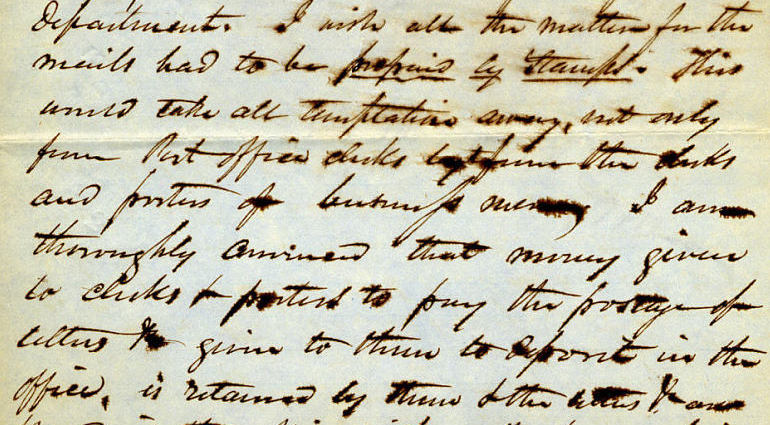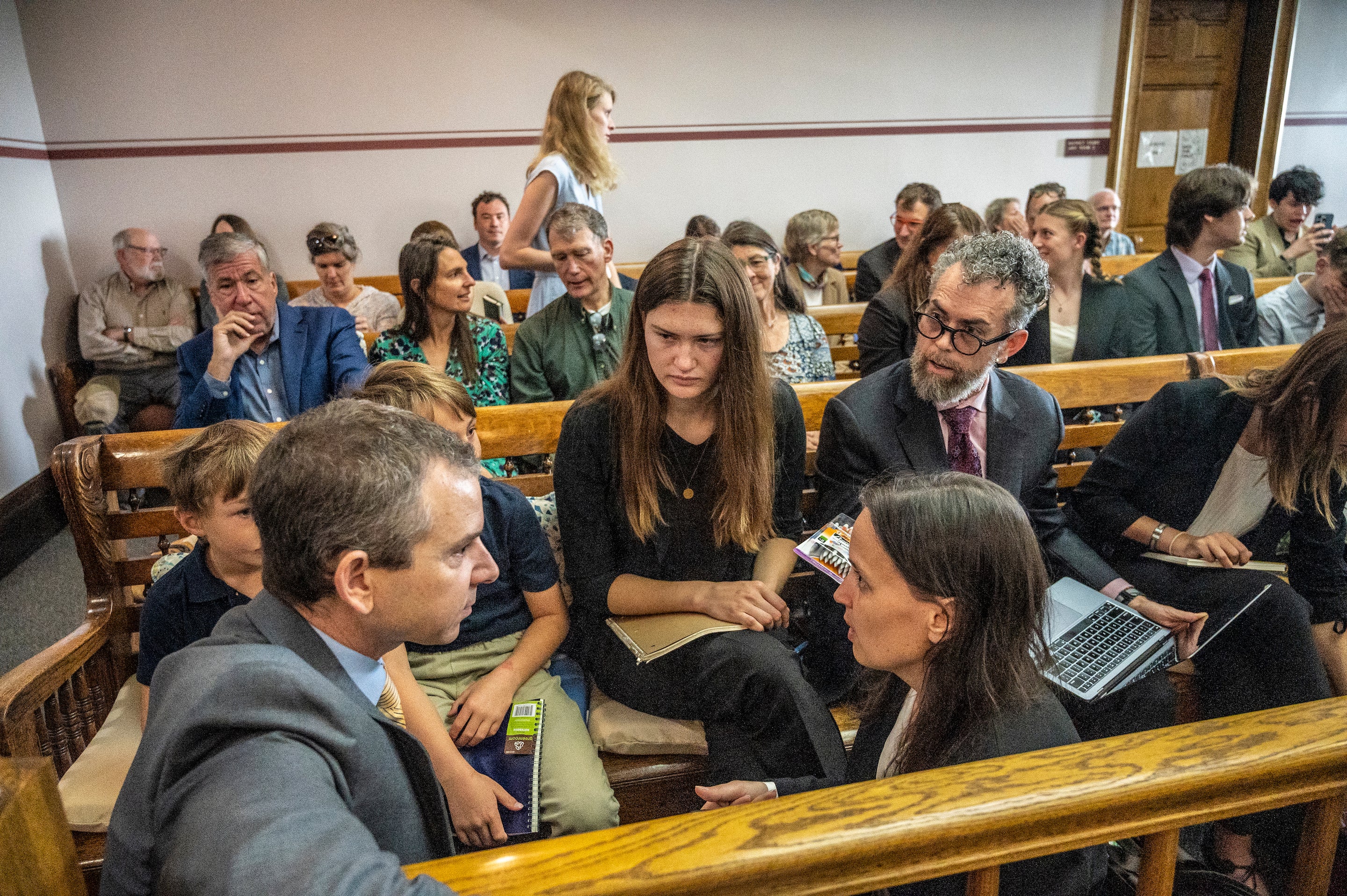A man of genius makes no mistakes. His errors are volitional and are the portals to discovery.
James Joyce, Ulysses (1922)
Technically known as “sorts,” the letters a print setter used were crafted from copper and stored like tiny inked seeds in a wooden case. Capitalized letters were kept in the top portion (hence “upper case”) and those that weren’t were stored in the bottom (thus “lower case”). Carefully fastened into an iron composing stick, the printer would spell out words and sentences which would be locked into a wood-frame galley and then organized into paragraphs and pages. Arranging sorts was laborious, and for smaller fonts, such as those used in a Bible, the pieces could be just a millimeter across. Long hours and fatigue, repetitive motion and sprained wrists, dim light and strained eyes—mistakes were inevitable.
The King James Version of the Bible has exactly 783,137 words, but unfortunately for the London print shop of Robert Barker and Martin Lucas, official purveyors to King Charles I, their 1631 edition left out three crucial letters, one crucial word—”not.” As such, their version of Exodus 20:14 read, “Thou shalt commit adultery.” Their royal patron was not amused. This edition was later deemed the “Wicked Bible.”
Literature’s history is a history of mistakes, errors, misapprehensions, simple typos. It’s the shadow narrative of expression—how we fail because of sloppiness, or ignorance, or simple tiredness. Blessed are the copyeditors, for theirs is a war of eternal attrition. Nothing done by humans is untouched by such fallenness, for to err is the universal lot of all of us. Authors make mistakes, as do editors, publishers, printers (and readers).
If error were simply an issue of a wrong comma here or an incorrect word there it wouldn’t be nearly as interesting, but mistakes undergird our lives, even our universe. They can be detrimental, beneficial, neutral. When Lockheed Martin designed the Mars Climate Orbiter using American units and NASA assumed that they’d used the metric system instead, a discrepancy that resulted in that satellite crashing into the red dust of the fourth planet from the sun—that was a mistake. And when the physician Alexander Fleming left out a culture plate which got contaminated, and he noticed the flourishing of a blue mold that turned out to be penicillin—that was a mistake. Errors in how people hear phonemes are what lead to the development of new languages; mistakes in an animal’s DNA propel evolution; getting lost can render new discoveries. Sometimes the flaw is that which is most beautiful.
Certainly, there are no shortage of them. Typographical errors such as those in the 1631 Bible are known as “errata,” and despite the incendiary mistake of Barker and Lucas, less salacious typos were common. A 1562 printing of the sternly doctrinaire translation the Geneva Bible prints Matthew 5:9 as “Blessed are the placemakers” rather than “peacemakers;” an 1823 version of the King James replaced “damsels” in Genesis 24:61 with “camels,” and as late as 1944 a printing of that same translation rendered the “holy women, who trusted God… being in subjection to their own husbands” in 1 Peter 3:5 as referring to those pious ladies listening to their “owl husbands.”
But not all errors seemed as innocent—in 1637, an unlucky compositor deleted one letter “s” from the sixth word and the single comma which was to follow it from Luke 23:32, so that it read “And there were also two other malefactors [with Jesus],” those two accidental deletions blasphemously impugning the moral rectitude of the savior. A 1653 printing stated that it was the unrighteous who would inherit the earth, a 1716 edition records Jeremiah 31:34 as telling us to “sin on more,” and a 1763 volume replaces the penultimate word “no” with “a,” so that Psalm 14:1 reads “the fool hath said in his heart there is a God.” Those copies were pulped, the printers fined 3,000 pounds. One wonders if the Lord wasn’t sending a message in a 1612 errata where Psalm 119:161 had the first word of the line “Princes” replaced, so that it now read, “Printers have persecuted me without cause.”
 Christ assured his apostles that he came not to destroy the law, and he might as well have added that he came not to amend, edit, revise, or misquote it either. Precision matters when it comes to scripture. Slipping up when transcribing God’s word can have perilous consequences concerning damnation or redemption, but a mistake in the law—and not just God’s law—can have pressing repercussions here on earth. Practicing law is, after all, nothing more than being able to interpret ambiguities, but sometimes mistakes are embedded in contract and legislation themselves. Jarndyce v. Jarndyce, Charles Dickens’s fictional Court of Chancery probate case in Bleak House, propels that novel’s byzantine plot for 912 pages because of conflicting disputes about a will. “The parties to it understand it least,” writes Dickens, “but it has been observed that no two Chancery lawyers can talk about it for five minutes without coming to a total disagreement as to all the premises.” Much depends on being able to reconcile those mistakes of phrasing, as “innumerable children have been born into the case; innumerable young people have married into it; innumerable old people have died out of it.”
Christ assured his apostles that he came not to destroy the law, and he might as well have added that he came not to amend, edit, revise, or misquote it either. Precision matters when it comes to scripture. Slipping up when transcribing God’s word can have perilous consequences concerning damnation or redemption, but a mistake in the law—and not just God’s law—can have pressing repercussions here on earth. Practicing law is, after all, nothing more than being able to interpret ambiguities, but sometimes mistakes are embedded in contract and legislation themselves. Jarndyce v. Jarndyce, Charles Dickens’s fictional Court of Chancery probate case in Bleak House, propels that novel’s byzantine plot for 912 pages because of conflicting disputes about a will. “The parties to it understand it least,” writes Dickens, “but it has been observed that no two Chancery lawyers can talk about it for five minutes without coming to a total disagreement as to all the premises.” Much depends on being able to reconcile those mistakes of phrasing, as “innumerable children have been born into the case; innumerable young people have married into it; innumerable old people have died out of it.”
Depending on whether ambiguity is a mistake or a strength, the law often codifies uncertainty. The U.S. Constitution isn’t particularly long—only a few pages—and yet it’s filled with grammatical and spelling errors, as well as confusing syntax that bedevils contemporary citizens. The word “choose” is rendered “chuse” several times, Capitalization is inconsistent, possessive apostrophes and those of contraction are often dropped, and even “Pensylvania” is misspelled.
Much more significant are the idiosyncrasies in punctuation: commas are placed between nouns and verbs, errant commas in the Second Amendment makes it unclear as to whether the right to bear arms is reserved for individuals or only “well regulated militias,” and a semicolon in Article VI seems to invalidate the Constitution itself. “The Constitution, and the Laws of the United States which shall be made in Pursuance thereof; and all Treaties made, or which shall be made, under the Authority of the United States, shall be the supreme Law of the Land.” Strictly speaking, the end stop of that semicolon implies that “all Treaties made,” and not the Constitution, shall be the supreme law of the land, and yet we’ve always just assumed it’s an obvious typo.
The Constitution has only a scant 4,543 words, but that a book as large as the Bible—783,137 words!—should see a few letters accidentally left out, even to potentially perilous soul-damning effect, isn’t so surprising. Adam Nicholson explains in God’s Secretaries: The Making of the King James Bible that when a nineteenth-century scholar “attempted to collate all the editions of the King James Bible then in circulation, he found more than 14,000 variations between them.” Nor were such blunders unique to print; anyone working with Medieval manuscripts is familiar with all of the human failings that render an incorrect Greek conjugation or a sloppy Latin declension, but there are even more blatant accidents. Dittography is common—that is, the doubling of a word word because a scribe happened to glance up and lose their place, thus repeating themselves. Homeoteleuton is another frequent peril, which is when a scribe takes a break and returns to where they were writing and, misled by a similar keyword, finishes with a latter sentence from whatever they are copying. Homeoarchy is the accidental deletion of lines; metathesis the reversing of letters in a wrod. An entirely more delightful flaw can be found in a fifteenth-century Croatian manuscript, where splayed across the pages are the inky pawprints of the scribe’s cat.
A small blip could be scratched out, but more extensive defects required radical editing. A copyist of the Abbey Bible, transcribed between 1250 to 1262 in Bologna, happened to leave out several verses from 1 Samuel, while garbling syntax in the ones which he did include. Rather than abandon expensive vellum, decorated with lustrous hues of cobalt, gilt, and burgundy, the scribe crossed out the offending portion with a set of blue and red lines and began over on the following page. Sometimes scribes made apologies in the marginalia for a poor showing; one Medieval Irish copyist explained his errors by writing, “Let me now be blamed for the script, for the ink is bad, and the vellum defective and the day is dark.”
Another particularly creative fellow, an English scribe from the late thirteenth century, deleted a line by accident, and so on the page’s borders he drew a little peasant using a pulley to hoist the missing sentence back into its correct spot. Not even the most beautiful manuscripts were without faults; the ninth-century Irish Book of Kells, its intricate Celtic knot work dyed in indigo and copper, ochre and lapis lazuli, flubs the genealogy of Jesus, while several passages are missing. Yet when the copyist rendered Christ’s declaration in Matthew 10:34, which is supposed to read, “I came not to send peace, but a sword,” as “I came not only to send peace, but joy,” one can’t help wonder if it’s an error or an improvement.
Returning to the Wicked Bible, the Archbishop of Canterbury George Abbot blamed the perfidious errata on what he saw as a slipshod operation, claiming that their “paper is naught, the composers boys, and the correctors unlearned.” The king didn’t find it funny, with the ecclesiastical historian Peter Helyn writing in 1669 that “Order was given for calling the Printers into the High-Commission where upon the Evidence of the Fact, the whole impression was called in, and the Printers deeply fined, as they justly merited.” Charles I had as many copies destroyed as could be found, the result being that only 15 survive in scholarly libraries; seven in Great Britain, including at the British Library and Oxford’s Bodleian; seven in North America, including at the New York Public Library and Yale, and one in Australia. By comparison, the first edition of Shakespeare‘s folio, printed a decade before in 1623, has a whopping 750 copies that have endured.
A 1632 copy of the King James also printed by Barker and Lucas—an edition which doesn’t say that it’s cool to cheat on your wife—is currently selling on AbeBooks for $3,250. By contrast, in 2015 a private buyer purchased a copy of the Wicked Bible from an Orlando book dealer for $99,500. That rarity commands price isn’t surprising, but that so often it’s the flaw that collectors’ eyes wander toward says something. It’s the slipup in the American Tobacco Company’s release of Pittsburgh Pirates shortstop Honus “The Flying Dutchman” Wagner‘s 1909 baseball card—largely destroyed at the behest of the anti-smoking fielder’s demand since they hadn’t first received his legal permission—which helped it sell at auction this last August for an astounding $6.6 million. The same reason that an “Inverted Jenny” U.S. Postal stamp that featured an upside-down blue biplane framed by a red border was bought at auction three years ago for $1,350,000 (the original would have been 24 cents). Or the popularity of Elias Garcia Martinez‘s 1930 workman-like fresco of Christ, which in 2012 was touched up by Cecelia Gimenez, an amateur art restorationist and parishioner at Borja, Spain’s Sanctuary of Mercy Church, and who rendered the Messiah not as the suffering servant but as something which looked like a chipper capuchin, leading some wags to christen the new piece Ecce Mono—Behold the Monkey. “The restoration has put Borja on the world map,” Gimenez said, “meaning I’ve done something for my village that nobody else was able to do.” Perhaps a failure, and yet because of the 81 year old’s accident the church was able to raise over $66,000 for charity. Enough to raise up praise, for as the Wicked Bible reads in another misprint—”Behold, the Lord our God hath shewed us his glory and his great-asse.”
There is a sublimity in inadvertency, a profundity in accident. Certainly an inevitability. Perhaps a lyric poet can polish the 14 lines of a sonnet to an immaculate sheen, but an ample preponderance of text is going to accrue some errors, just as no consumer can avoid a few spider legs in their peanut butter and the FDA sets limits on the number of rodent hairs acceptable in your oatmeal. A finished novel will go through rounds of revisions at the hands of the author, sometimes a whole coterie of copyeditors, and any number of eyes that will see it before ink is pressed onto paper, and still a carefully examined book will inevitably have typos. The fact is that these sorts of mistakes, while perhaps embarrassing, are also largely irrelevant, and few notice them other than anal-retentive punctilious prigs. Yet when they’re noticeable, they’re noticeable. Possibly expensive as well; just ask Jonathan Franzen, whose novel Freedom had a first printing accidentally based on a rough draft, with HarperCollins producing 80,000 error-laden novels and selling a tenth of them in the United Kingdom before noticing. Franzen writes of how a “wealth of experience with mistake-making would have been a comforting resource” in the (corrected edition) of Freedom, but then again, maybe not. There are less disastrous instances as well. Theodor Dreiser‘s An American Tragedy describes a pair of lovers as being “like two small chips being tossed about on a rough but friendly sea,” while Daniel Defoe tells us that Robinson Crusoe stripped naked, swam out to his sinking ship and retrieved supplies, which he then stored in his pockets on the returning laps. As Horace noted, even Homer nods.
When it was claimed that Shakespeare never blotted out a single word, his theatrical colleague and noted frenemy Ben Jonson quipped, “Would he had blotted out a thousand.” For all his genius, the Bard was often uninformed or lazy, author of a veritable comedy of errors. The Winter’s Tale references landlocked Bohemia as having a coast. In Julius Caesar, Cassius uses a clock some 14 centuries before they were invented, and in The Two Gentlemen of Verona they sail from that titular city to Milan, a geographic impossibility. Those are the mistakes that remain in modern editions, but as Marjorie Garber reminds us in Shakespeare After All, the version that “we have come to admire, revere, quote and cite” is rendered from that which has been “improved and altered over time by the conjectures of editors trying to make sense of what may appear to be gaps or errors.”
When all literary details are fodder for close reading, every choice of “that” over “which,” every single comma, every instance of plotting, then the blunder is a rock that we trip over. Not infrequently that which announces itself as a fault was intentional; when Richard Tottel printed Songes and Sonnets in 1557, an anthology that posthumously reproduced the poetry manuscripts of Thomas Wyatt and Henry Howard, he “corrected” their visionary prosody; Thomas Wentworth Higginson infamously “cleaned up” the radical punctuation of Emily Dickinson‘s poems in his 1890 publication; and in 1677 John Dryden “fixed” the blank verse of John Milton‘s Paradise Lost in the former’s libretto The State of Innocence, having decided that what it needed was a plodding rhyme scheme where “In liquid burnings, or on dry, to dwell,/Is all the sad variety of hell.”
Some errors are so obvious that there is no need to parse their significance. When William Faulkner makes clear in Sanctuary that a scene takes place at 5:30, and then a few sentences later he writes that it’s “almost seven oclock,” that doesn’t belie some deep metaphysical profundity—it’s a screwup. Because of his convoluted editing history, these sorts of gaffes aren’t uncommon in Faulkner, with nothing more infamous than the ever-shifting architecture and history of the McCaslin-Edmonds Plantation in Go Down, Moses. Sometimes the house was built in 1813, in other stories it predates 1807; occasionally it’s a modest “two-room mud-chinked log half domicile and half fort” and in other descriptions it’s a neo-classical, porticoed, columned, mansion featuring “clapboard and Greek revival and steamboat scrollwork.” Faulkner didn’t intend for McCaslin-Edmonds to be so mercurial—the flub doesn’t mean anything. But in some ways, it means everything. Because a mistake reminds us that fiction is artifice, announcing the illusion to all of us, and reaffirming that it’s been crafted by a fallible human. For the writer, every perfect sentence comes from some place higher; every flawed example is irredeemably your own. Furthermore, a slip up uncomfortably announces just how much of composition is unconscious, beyond the mere dictates of planning and a speaking. The error is a window where that force which compels the writer takes a moment to peak out into the world.
Other accidents are more ambiguous than Faulkner’s clear continuity errors. In his 1816 poem, John Keats famously compares the experience of his first reading George Chapman‘s Homeric translations to being “like stout Cortez when with eagle eyes/He stared at the Pacific,” except the first European to see the western coast of that ocean was actually Vasco Núñez de Balboa. Did Keats just not know this, or was this intentional? Does the purposefulness or not of the inaccuracy matter to how we read the lyric? Or take Franz Kafka‘s incendiary beginning to his unfinished 1927 novel Amerika, wherein European émigré Karl Roßmann arrives in New York Harbor and from the bow of his ship he studies the Statue of Liberty, describing how the “arm with the sword now reached aloft.” Is this a mistake—did Kafka not know what the statue actually looked like? Is it a comment on the United States, perhaps? It’s uncertain, and yet as with all of Kafka’s oeuvre, such a strange detail seems pregnant with meaning, even if a slipup. Whether or not it’s the wiseman or his opposite who claims, “There is no such thing as a mistake,” we can’t quite dispel the desire for purpose, and so we read even blunders as having import. Unconsciousness is useful here, for then some part of Faulkner’s mind hidden even to himself wanted McCaslin-Edmonds to have its variable description; if Kafka floundered into that martial Statue of Liberty, it must have reflected something deep within.
“A slip of the tongue can be amusing,” notes Sigmund Freud in The Psychopathology of Everyday Life, “and may be very welcome to the doctor practicing psychoanalytical methods.” An instance of Fehlleistung, which in German roughly translates into “faulty performance,” and that early English editions rendered as “parapraxis,” but which everyone else calls a Freudian slip. These are the fumbled turns of phrase where the unconscious has commandeered the tongue, the mistakes which aren’t really mistakes. “For seven and a half years I’ve worked alongside President Reagan,” then Vice President George H.W. Bush said in a speech during his second term. “We’ve had triumphs. Made some mistakes. We’ve had some sex—setbacks.” The crowd giggles; Freud wouldn’t think this misspeaking so innocent. While campaigning for Mitt Romney in 2012, Senator John McCain said, “I am confident with the leadership… President Obama will turn this country around,” inadvertently endorsing the governor’s opponent. Fehlleistung encompasses tongue slips, events that are misremembered, words that are misheard, and the phrase that cannot be found. Freud argues in An Autobiographical Study that “these phenomena are not accidental… they have a meaning and can be interpreted, and that one is justified in inferring from them the presence of restrained or repressed impulses and intentions.” Bush didn’t commit a gaffe—he was stating repressed carnal desires (I’ll hold to that interpretation). Therapists today place less emphasis on tongue slips, yet it’s hard not to think that at least the sentiment behind Fehlleistung is something we intuit. We suspect that we’re witness to a confession rather than a trifling error. That’s why Charles I punished Barker for his errata—the sin outed itself while his mouth protested innocence.
Psychology remains the science of remedying our mistakes. From psychoanalysis to cognitive behavioral therapy, psychologists work to assist their patients in understanding how delusions, obsessions, compulsions, anxieties, and so on, are based in faulty understanding. Neurotics may fear that there are castles in the sky while psychotics live in them, but both are erroneous about there being anything above other than clouds. We are wrong about fears which are irrelevant and ignore those that are pressing, we return to past sleights and embarrassments that are irrelevant, we are angry at people who are undeserving and admire those who aren’t worthy. An argument could be made that fiction is the mode for exploring those misapprehensions, but mistake can’t be reduced to conflict, problem, or mystery, though literature certainly explores the tragic implications of error. When error comes up against cold reality the result is often guilt. Think of Edgar Allan Poe‘s “The Tell-Tale Heart,” whose narrator murders an old man because of his glassy eye and is driven into a frenzy by what he perceives to be the sound of the dead man’s beating heart, believing that “what you mistake for madness is but over-acuteness of the senses.” Here an error—a pathology, really—the belief that there is a dead heart loudly beating under the floorboards—reveals a hidden truth. Then there is the initial mistake, if a crime is a mistake (frequently it is), of the narrator’s heinous act, based on his own delusions about the nature of his victim.
Failure, which is just a mistake with legs, can be far less ghoulish than it is in Poe’s story, even if no less mad. Charles Jackson‘s arresting novel about alcoholism The Lost Weekend dramatizes how a certain mistake made by those who can’t afford it—the fallacy that those of us who are unable to drink can have just one—is repeated to terrible consequence. A counselor explains to Don Burnham, the drunken adman who is the central protagonist, that folks like him “can’t bring themselves to admit they’re alcoholics, or that liquors got them licked. They believe that can take it or leave it alone—so they take it… promising they’ll take one, or at the most two, and—well, then it becomes the same old story.” Sometimes the writing itself is the mistake. Journalist Geoff Dyer was tasked with a biography of D.H. Lawrence, but being stalled he wrote a meta-book about his inability to complete the project. “I do everything badly, sloppily, to get it over with so that I can get on to the next thing that I will do badly and sloppily,” Dyer writes. His Out of Sheer Rage: In the Shadow of D.H. Lawrence is by definition a blunder, but one where he turns failure into a triumph. “Like it or not you have to try to do something with your life, you have to keep plugging away,” Dyer writes, an echo of Samuel Becket‘s paeon to fucking up when he writes in his play Worstward Ho!, “Ever tried. Ever failed. No matter. Try again. Fail again. Fail better.” That bit is the portion that ends up in inspirational greeting cards sold at Whole Foods, but the untruncated passage is a bit more despairing. “Or better worse. Fail worse again. Still worse again. Till sick for good. Throw up for good. Go for good,” writes Beckett. Some might find this a downer, but I think it’s more inspiring.
If writers make mistakes, explore mistakes, celebrate mistakes, and embrace lives that are mistakes, they also can use mistakes. During the Victorian era there was a method of composition which left everything up to chance, codified fortuitous error. Automatism is a method of composition that eliminates flaws from writing by making everything an error. First practiced in the gilded drawing rooms of upstate New York or the English Lake District, where wealthy freethinking women in tight-lace corsets and bustles and their husbands in starched collars sat about tables summoning the dead at seances, automatism involved turning the mind off while writing, so that a person could be a conduit through which words arrived. Whole books were written this way: Spiritualists like Patience Worth claimed that her automatic writing led to poetry and novels from authors living in the hereafter; her contemporary Emily Grant Hutchings asserted that Mark Twain dictated Jap Heron: A Novel of the Ouija Board to her from the astral realms in 1917 (the judge in the ensuing copyright hearing disagreed, concluding that the book was of too poor of a quality to be by Clemons). William Butler Yeats was the most respected author to take automatism seriously, using Ouija boards, tarot cards, and other occult paraphernalia to generate verse which he claimed came from a long dead spirit named Leo Africanus. As one of them wrote, “If spirits seem to stand/Before the bodily eyes, speak into the bodily ears, /They are not present but their messengers.”
Dadaists and Surrealists practiced automatism so as to indulge Fehlleistung—to make everything a slip. In dismal rooms above shops on the great avenues of Paris and Zurich, the air thick with hash smoke, poets like André Breton and Philippe Soupault ceded authorial intentionality to the whims of their hidden thoughts, letting the fingers on the keys of their Remingtons and within their smudged Moleskins freely perambulate. A heaven with no blockage, entirely structured by what could be seen as error. “Write quickly, without preconceived subject, fast enough so that you will not remember what you’re writing,” explains Breton in The Surrealist Manifesto. “The first sentence will come spontaneously, so compelling is the truth that with every passing second there is a sentence unknown to our consciousness which is only crying out to be heard.” If the unconscious makes possible the mystery of any writing, then the Surrealists were at least honest about that score. “The rail stations were dead, flowing like bees stung from honeysuckle,” write Breton and Soupault in their 1919 experimental novel The Magnetic Fields. “The people hung back and watched the ocean, animals flew in and out of focus. The time had come.” What does any of that mean? Who knows—least of all its authors. Automatism isn’t writing with a few moments of carelessness, its carelessness turned into writing. Paradoxically, in their oracular exactitude, their dream-like logic, such writings seem anything but careless. What Breton promised in his study The Automatic Message was, “Thought’s dictation, free from any control by the reason, independent of any aesthetic or moral preoccupation.” Error elevated to art.
Surrealists were fascinated with how to cede control. Techniques were developed to force what any conventional artist would consider faults, and to make these their work’s basis. The Cut-up technique, made famous by Beat writer William S. Burroughs in Naked Lunch, involved cutting out portions of your own writing and randomly rearranging it, for as “one judge said to the other, ‘Be just and if you can’t be just be arbitrary.’” Many Surrealist techniques have the feel of parlor games, which is not incidental. Some of the most experimental methods of the Avant-Garde migrated into the sorts of things you may have done at summer camp. Alastair Brotchie writes in A Book of Surrealist Games that through play, Surrealists “subverted academic modes of enquiry, and undermined the complacent certainties of the reasonable and respectable.” Exquisite Corpse is the most enduring method of Surrealists, a form of collaborative artistic endeavor where each author offers in turn an adjective, noun, adverb, verb, adjective and noun, from whence the game derives its name after the game’s inventors generated the sentence “The exquisite corpse shall drink the new wine.” Today the game is associated with illustration where it is called Consequences, with one artist drawing the head of a figure, the next participant illustrating a torso, and the final player drawing the lower regions, resulting in a collectively generated chimera.
Monsters dwelled in our thoughts long before the Surrealists. A mammoth’s skull is unearthed, and somebody assumes that the nasal cavity is the eye socket of a cyclops; dinosaur bones evoke dragons. Albrecht Dürer, the great German painter and printmaker, never saw a rhinoceros with his own eyes, but that didn’t stop him from making a 1515 woodcut that remains the most enduring depiction of the animal. Having rendered his drawing from eyewitness accounts of those who did see a rhinoceros brought from India to Portugal, the first since the Roman era, and from a distance Dürer’s drawing conjures the idea of the creature, if not the actual species. The printer captures the heft of the rhinoceros, the thickness of its hide and the bulk of its weight, the cumbersome awkwardness of its form. Obviously the horn is there. “This is an accurate representation,” the woodcut’s German inscription reads, and yet in the details virtually none of it is. Dürer shows the rhinoceros as covered in thick, segmented, armored plates; he has a small horn on his hindquarters, and his scaled legs are clearly that of a reptile. Ganda, the animal’s Gujarati name given to him when the rhinoceros embarked from Goa to Lisbon, would drown off the Ligurian coast while being transported to Pope Leo X. A final fatal mistake. Elena Passarello writes of Ganda in Animals Strike Curious Poses with the heartbreaking detail that on his voyage he was wrapped in “green velvet and decked with carnations and gilt rope, perhaps to mimic wedding garb,” dressed for an appointment that he’d miss.
To those crowds who gathered at Estaus Palace to watch Ganda fight one of King Manuel’s elephants (the latter was frightened and ran off), or King Francis I of France who waited in Marseille so that he could see the animal disembark briefly on its way to Italy, or for the Medici Pope who was to add the doomed rhinoceros to his own menagerie, such a beast must have seemed like a divine mistake. His cumbersome heft and pachyderm mouth, Ganda’s knobby thick skin and that priapic horn. For Renaissance Europeans, there was something fantastical about a rhinoceros; Dürer’s woodcut was the first widely disseminated picture of the species since the first-century quadrans minted during the reign of Domitian when those creatures weren’t uncommon in the Colosseum. So distant was the memory of such megafauna, that some assumed Pliny the Elder‘s description from Natural History of this fierce monster was more myth than animal. Pliny lists two creatures as the rhinoceros’ natural enemy; the first is the elephant, and the second is the dragon. When Manuel paraded Ganda through Lisbon, there must have been a sense that God is capable of anything, for the line between a wonder and a freak is thin. So unusual is the long neck of the giraffe, the nose of the elephant, and of course the horn of the rhinoceros, that unless observed with your own eyes it can seem as fantastical as anything in a Medieval bestiary.
Women and men born with unfamiliar variations—the seventeenth-century Spanish courtier Petrus Gonsalvus who along with his children had hypertrichosis and thus appeared to his contemporaries as if he was a wolf-man; John Merrick in the nineteenth-century whose Proteus syndrome caused huge swellings on his hand and face which led to him being exhibited as the Elephant Man; Madame Dimanche, a nineteenth-century Parisian widow who had a ten inch cutaneous horn which grew from her forehead, and looked nothing so much as a rhino horn. Such human beings—human beings—were oft displayed at circuses and carnivals, freaks shows and geek shows, slandered by physician and cleric alike as being “mistakes” within the order of things. “The term freak is actually of some interest,” writes Jan Bondeson in The Two-headed Boy, and Other Medical Marvels, “as it originates in the expression ‘freak of nature,’ implying that the malformed child was a unique, unclassifiable phenomenon, the result of some strange ‘maternal impression,’ a witch’s curse, or divine displeasure.”
The result of such categorization is predictable—dehumanization, persecution, oppression. Those who didn’t match normative expectations were placed first outside the divine order, and later outside the biological order. The result was the same, the slandering of people as being inferior because of physiognomy. The basic, sacred, and inviolate rule is actually rather simple, however—no human being is a mistake. Merrick, a man of uncommon intelligence, grace, and empathy, expressed it well. In letters which he wrote, he would end with a poem by the eighteenth-century hymnologist Isaac Watts: “‘Tis true my form is something odd, /But blaming me is blaming God.”
Biology doesn’t broach “mistakes” exactly, for a variation or mutation or adaptation is neutral in and of itself. It’s only in how well suited that variation is to survival that it proves advantageous or not, all of which depends on environment. Ganda’s horn may have seemed a fearsome ornament, but as Pliny wrote—albeit with some details a bit shaky—his protuberance was estimably practical; he prepares “for the combat by sharpening its horn against the rocks; and in fighting directs it chiefly against the belly of its adversary, which it knows to be the softest part.” Such fortunate oddities are a result of adaptation, of generations of rhinoceroses born with shorter and longer horns, with natural selection sorting out which is better suited. Charles Darwin defines natural selection in On the Origin of Species as simply the “preservation of favorable variations and the rejection of injurious variations,” so that a rhino’s horn may be well adapted to the rainforest but poorly to a Mediterranean boat. Darwin explains that “any variation, however slight and from whatever cause proceeding, if it be in any degree profitable to an individual… will tend to the preservation of that individual, and… its offspring.” A Galapagos finch’s beak which is a bit larger may seem flawed, though better at cracking a nut; a moth’s wings that are smudgy looks marred, but it can blend into a smoggy London park better. The mechanism of mutation was a mystery to Darwin, awaiting a fuller understanding of genetics, but if anything this fuller understanding demonstrated how much we owe to mistakes. “Mutations arise from errors made by the machinery that copies or repairs DNA,” explains Armand Marie Leroi in Mutants: On Genetic Variety and the Human Body, the adaptations which emerge in a species due to the sloppiness of replication at the cellular level. Life itself propagates from the intransigence of error since the very beginning, when a spicy primordial stew of amino acids first coalesced.
Reality itself depends on broken symmetry. Physicists speak so much of elegance—beautiful theories, beautiful mathematics, beautiful equations—that one is tempted to see them as practicing aesthetics. “Physicists love symmetry because it has a mathematical and intuitive beauty,” explains Leon Lederman in The God Particle: If the Universe is the Answer, What is the Question? Yet there is a lack of elegance deep within our universe. For example, it could be expected that there should be equivalent amounts of matter and antimatter, the latter referring to the mirror-image version of the former, where their quantum numbers—including attributes like charge—are the opposite. Electrons, those elementary particles that circle the nuclei of atoms, have negative charge, but their opposite of a positron has (predictably) positive charge. It would be expected that in a harmonious universe there would be equal numbers of both, but we’re lucky that there isn’t, because when matter meets antimatter the result is a flash of pure energy. Such an asymmetry is the only reason why anything is here.
Considering this inelegance, Lederman sighs that “our depression is tempered by the faith that when all is known, a deeper beauty will be revealed.” Quantum mechanics is historically content with garish potentiality, however; particles which are also waves smeared across space, with everything reduced to probabilities. Because Werner Heisenberg‘s uncertainty principle says that the exact location of a particle or an amount of energy in infinitesimally small areas is indeterminate, there is a rich virtual mélange of particles forever popping in and out of existence along with their antimatter siblings. That these pairs of virtual particles always come twinned is a bit of cosmic bookkeeping due to laws of conservation, perhaps indicative of that deeper symmetry that Lederman pines for.
Something else here though, because these quantum fluctuations are their own kind of mistake, with uncertainty providing a loan from reality that’s paid off in nanoseconds. “They live on borrowed momentum, borrowed energy, and borrowed time,” explains Robert Oerter in The Theory of Almost Everything: The Standard Model, the Unsung Triumph of Modern Physics. Because you can never say with utmost certainty that there’s zero amount of energy in a vacuum—nothing is ever certain—then there is also nothing that’s ever really a vacuum. An explanation of why there is something rather than nothing, that question which has bothered philosophy from the pre-Socratics until today. If reality began with the Big Bang—and all data indicates that it did—the problem still remains of why. Quantum fluctuation provide an explanation—it was all just a mistake from the get-go. That is to say that our universe began just like those virtual particles, in some other place that isn’t here. With infinite time it would stand to reason a virtual universe would emerge. As physicist Steven Weinberg wrote in The First Three Minutes: A Modern View of the Origin of the Universe, “The more the universe seems comprehensible, the more it also seems pointless.” Far from nihilism. Anything pointless is also perfect, and nothing is more pointless than nothing. Come again?
In the sixteenth century, Rabbi Isaac ben Solomon Luria Ashkenazi gathered his followers at Safed to contemplate our fallen creation. The Ari, or “Lion,” as he was known, had his fellow kabbalists meet the Sabbath at dusk, facing towards Jerusalem and rubbing soil in their eyes, davening Hebrew prayers about the initial rupture in perfection. Wrapping tefillin underneath olive trees, the Ari promulgated a new understanding. Even in traditional Kabbalah, before the beginning, everything was the Ein-Sof, the perfected, incomprehensible, undifferentiated glory of God. The Zohar explains that God “was alone, without form and without resemblance to anything else.” Such a Lord was like that singularity which physicists speak of, that perfected state without time and space in which error couldn’t exist. But nothing else could either. And as a random quantum fluctuation birthed our reality, the Ari taught that the Ein-Sof contracted within itself so space for the created universe could expand outward, a process called Tzimtzum. The first mistake which made all others possible. But oh, what a beautiful mistake it was! Every joy and every sorrow, every love and every hatred, every triumph and degradation first emerged from a crack in nothing. The imperfection is what is profound, the marring is what is beautiful. The Ari taught that the meaning of our lives was a process of rebuilding that which had been broken—a task of editing, if you will. Tikkun Olam refers to the erasing of those original typos. “And so it is/now and till twilight,” the Ari explained about this task of fixing. To delete a comma is perhaps to address an injustice, to add a word is possibly to perform a charity, and all of those little acts of the red pen, all of our collective choices, revising and editing for when all errors will be reconciled again in that final draft.
























































































